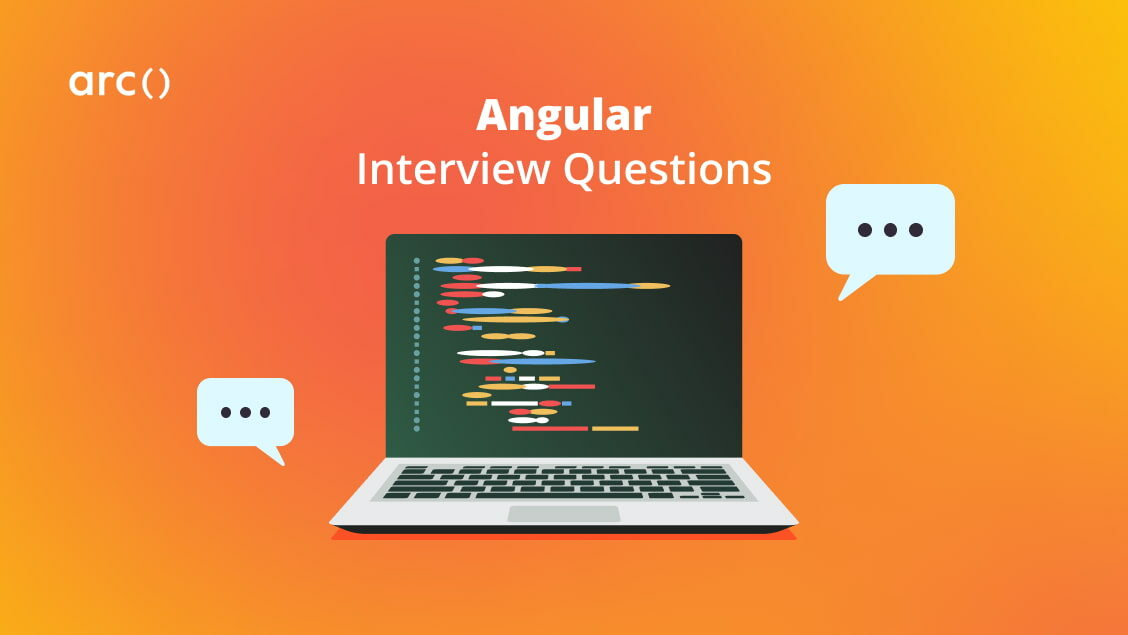Have an AngularJS interview coming up? Whether you’re the hiring manager or an Angular developer, we worked with experienced developers at Arc to share their top Angular interview questions and answers.
Use these questions to help test a developer’s understanding of this popular JavaScript framework, developed by Google.
Aside from these questions, as JavaScript and Angular are tightly knit together, refer to these 65 JavaScript Interview Questions to draft a comprehensive interview guide.
Let’s jump in!
Looking to hire the best remote developers? Arc can help you:
⚡️ Get instant candidate matches without searching
⚡️ Identify top applicants from our network of 350,000+
⚡️ Hire 4x faster with vetted candidates (qualified and interview-ready)
Try Arc to hire top developers now →
1. What are the basic steps to unit test an AngularJS filter?
- Inject the module that contains the filter.
- Provide any mocks that the filter relies on.
- Get an instance of the filter using
$filter('yourFilterName'). - Assert your expectations.
Dependency injection is a powerful software design pattern that Angular employs to compose responsibilities through an intrinsic interface. However, for those new to the process, it can be puzzling where you need to configure and mock these dependencies when creating your isolated unit tests. The open-source project “Angular Test Patterns” is a free resource that is focused on dispelling such confusion through high-quality examples.
This question is useful since it can give you a feel for how familiar the candidate is with automated testing (TDD, BDD, E2E), as well as open up a conversation about approaches to code quality.
Sources:
https://github.com/daniellmb/angular-test-patterns/blob/master/patterns/filter.md
https://docs.angularjs.org/guide/unit-testing
2. What should be the maximum number of concurrent “watches”? Bonus: How would you keep an eye on that number?
TL;DR Summary: To reduce memory consumption and improve performance, limit the number of watches on a page to 2,000. A utility called ng-stats can help track your watch count and digest cycles.
Jank happens when your application cannot keep up with the screen refresh rate. To achieve 60 frames-per-second, you only have about 16 milliseconds for your code to execute. It is crucial that the scope digest cycles are as short as possible for your application to be responsive and smooth.
Memory use and digest cycle performance are directly affected by the number of active watches. Therefore, it is best to keep the number of watches below 2,000. The open-source utility ng-stats gives developers insight into the number of watches Angular is managing, as well as the frequency and duration of digest cycles over time.
Caution: Be wary of relying on a “single magic metric” as the golden rule to follow. You must take the context of your application into account. The number of watches is simply a basic health signal. If you have many thousands of watches, or worse, if you see that number continue to grow as you interact with your page. Those are strong indications that you should look under the hood and review your code.
This Angular interview question is valuable as it gives insight into how the candidate debugs runtime issues while creating a discussion about performance and optimization.
Sources:
https://github.com/kentcdodds/ng-stats
http://jankfree.org
3. How do you share data between controllers?
Create an AngularJS service that will hold the data and inject it inside of the controllers.
Using a service is the cleanest, fastest, and easiest way to test. However, there are a couple of other ways to implement data sharing between controllers, like:
– Using events
– Using $parent, nextSibling, controllerAs, etc. to directly access the controllers
– Using the $rootScope to add the data on (not a good practice)
The methods above are all correct, but are not the most efficient and easy to test.
4. What is the difference between ng-show/ng-hide and ng-if directives?
ng-show/ng-hide will always insert the DOM element, but will display/hide it based on the condition. ng-if will not insert the DOM element until the condition is not fulfilled.
ng-if is better when we needed the DOM to be loaded conditionally, as it will help load the page a bit faster compared to ng-show/ng-hide.
We only need to keep in mind the difference between these directives. Developers can decide which one to use depending on the task requirements.
5. What is a digest cycle in AngularJS?
In each digest cycle, Angular compares the old and the new version of the scope model values. The digest cycle is triggered automatically. We can also use $apply() if we want to trigger the digest cycle manually.
For more information, take a look at the ng-book explanation: The Digest Loop and $apply
Struggling with interview prep? Meet senior developers from Amazon, Microsoft, and Google now on Codementor. They’ll help you tackle coding challenges, practice interviews, and sharpen your skills in live 1:1 sessions.
Book a session with our interview prep tutors today! Your first 15 minutes are free.
Explore our other software development interview questions and answers to prep for your next remote job.
6. Where should we implement the DOM manipulation in AngularJS?
In the directives. DOM Manipulations should not exist in controllers, services or anywhere else but in directives.
Here is a detailed explanation.
7. Is it a good or bad practice to use AngularJS together with jQuery?
It is definitely a bad practice. Developers need to avoid jQuery and try to realize the solution with an Angular approach. jQuery takes a traditional imperative approach to manipulating the DOM, and in an imperative approach, it is up to the programmer to express the individual steps leading up to the desired outcome.
AngularJS, however, takes a declarative approach to DOM manipulation. Here, instead of worrying about all of the step-by-step details regarding how to get the desired outcome, we are just declaring what we want, and Angular will take care of everything for us.
Here is a detailed explanation.
8. If you were to migrate from Angular 1.4 to Angular 1.5, what is the main thing that would need refactoring?
Changing .directive to .component to adapt to the new Angular 1.5 components.
9. How would you specify that a scope variable should have one-time binding only?
By using “::” in front of it. This allows you to check if the candidate is aware of the available variable bindings in AngularJS.
10. What is the difference between one-way binding and two-way binding?
- One-way binding implies that the scope variable in the html will be set to the first value its model is bound to (i.e., assigned to)
- Two-way binding implies that the scope variable will change its value every time its model is assigned to a different value
Basic Angular interview questions like this one are asked to assess your knowledge of HTML attributes, DOM properties, and other syntax-related aspects.
11. Explain how $scope.$apply() works
$scope.$apply re-evaluates all the declared ng-models and applies the change to any that have been altered (i.e. assigned to a new value) Explanation: $scope.$apply() is one of the core angular functions that should never be used explicitly, it forces the angular engine to run on all the watched variables and all external variables and apply the changes to their values.
Source: https://docs.angularjs.org/api/ng/type/$rootScope.Scope
12. What directive would you use to hide elements from the HTML DOM by removing them from that DOM without changing their styling?
The ngIf directive, when applied to an element, will remove that element from the DOM if its condition is false.
13. What makes the angular.copy() method so powerful?
It creates a deep copy of the variable.
A deep copy of a variable means it doesn’t point to the same memory reference as that variable. Usually assigning one variable to another creates a “shallow copy”, which makes the two variables point to the same memory reference. Therefore if one is changed, the other changes as well.
Sources:
https://docs.angularjs.org/api/ng/function/angular.copy
https://en.wikipedia.org/wiki/Object_copying
14. How would you make an Angular service return a promise? Write a code snippet as an example
To add promise functionality to a service, we inject the “$q” dependency in the service, and then use it like so:
angular.factory('testService', function($q) {
return {
getName: function() {
var deferred = $q.defer();
//API call here that returns data
testAPI.getName().then(function(name) {
deferred.resolve(name);
});
return deferred.promise;
}
};
});The $q library is a helper provider that implements promises and deferred objects to enable asynchronous functionality.
Source: https://docs.angularjs.org/api/ng/service/$q
15. What is the role of services in AngularJS and name any services made available by default
AngularJS Services are objects that provide separation of concerns to an AngularJS app. These can be created using a factory method or a service method. Services are singleton components and all components of the application (into which the service is injected) will work with single instance of the service. An AngularJS service allows developing of business logic without depending on the View logic which will work with it.
Few of the inbuilt services in Angular are:
- the
$httpservice: The $http service is a core Angular service that facilitates communication with the remote HTTP servers via the browser’s XMLHttpRequest object or via JSONP - the
$logservice: Simple service for logging. Default implementation safely writes the message into the browser’s console - the
$anchorScroll: it scrolls to the element related to the specified hash or (if omitted) to the current value of $location.hash() Why should one know about AngularJS Services, you may ask. Well, understanding the purpose of AngularJS Services helps bring modularity to AngularJS code
Services are the best may to evolve reusable API within and Angular app.
Overview:
- AngularJS Services help create reusable components.
- A Service can be created either using the
service()method or thefactory()method. - A typical service can be injected into another service or into an Angular Controller.
Sources:
https://docs.angularjs.org/guide/services
http://www.tutorialspoint.com/angularjs/angularjs_services.htm

16. When creating a directive, it can be used in several different ways in the view. Which ways for using a directive do you know? How do you define the way your directive will be used?
When you create a directive, it can be used as an attribute, element or class name. To define which way to use, you need to set the restrict option in your directive declaration.
The restrict option is typically set to:
‘A’ – only matches attribute name ‘E’ – only matches element name
‘C’ – only matches class name
These restrictions can all be combined as needed:
‘AEC’ – matches either attribute or element or class name
For more information, feel free to check out the AngularJS documentation.
17. When should you use an attribute versus an element?
Use an element when you are creating a component that is in control of the template. Use an attribute when you are decorating an existing element with new functionality.
This topic is important as it gauges whether developers understand how a directive can be used inside a view and when to use each way.
Source: https://docs.angularjs.org/api/ng/service/$compile#directive-definition-object
18. How do you reset a $timeout, $interval(), and disable a $watch()?
To reset a timeout and/or $interval, assign the result of the function to a variable and then call the .cancel() function:
var customTimeout = $timeout(function() {
// arbitrary code
}, 55);
$timeout.cancel(customTimeout);
To disable $watch(), we call its deregistration function. $watch() then returns a deregistration function that we store to a variable and that will be called for cleanup:
var deregisterWatchFn = $scope.$on('$destroy', function() {
// we invoke that deregistration function, to disable the watch
deregisterWatchFn();
});
19. Explain what is a $scope in AngularJS.
Scope is an object that refers to the application model. It is an execution context for expressions. Scopes are arranged in a hierarchical structure which mimics the DOM structure of the application. Scopes can watch expressions and propagate events. Scopes are objects that refer to the model. They act as glue between controller and view.
This question is important as it will judge a developer’s knowledge about a $scope object, and it is one of the most important concepts in AngularJS. Scope acts like a bridge between view and model.
Source: https://docs.angularjs.org/guide/scope
20. What are Directives?
Directives are markers on a DOM element (such as an attribute, element name, comment or CSS class) that tell AngularJS’s HTML compiler ($compile) to attach a specified behavior to that DOM element (e.g. via event listeners), or even to transform the DOM element and its children.
Angular comes with a set of these directives built-in, like ngBind, ngModel, and ngClass. Much like you create controllers and services, you can create your own directives for Angular to use. When Angular bootstraps your application, the HTML compiler traverses the DOM matching directives against the DOM elements.
This question is important because directives define the UI while defining a single-page app. Candidates need to be very clear about creating a new custom directive or using existing ones already pre-build in AngularJS.
Source: https://docs.angularjs.org/guide/directive
21. What is DDO Directive Definition Object?
DDO is an object used while creating a custom directive. A standard DDO object has the following parameters:
var directiveDefinitionObject = {
priority: 0,
template: '<div></div>', // or // function(tElement, tAttrs) { ... },
// or
// templateUrl: 'directive.html', // or // function(tElement, tAttrs) { ... },
transclude: false,
restrict: 'A',
templateNamespace: 'html',
scope: false,
controller: function(
$scope,
$element,
$attrs,
$transclude,
otherInjectables
) { ... },
controllerAs: 'stringIdentifier',
bindToController: false,
require: 'siblingDirectiveName', // or // ['^parentDirectiveName', '?optionalDirectiveName', '?^optionalParent'],
compile: function compile(tElement, tAttrs, transclude) {
return {
pre: function preLink(scope, iElement, iAttrs, controller) { ... },
post: function postLink(scope, iElement, iAttrs, controller) { ... }
};
// or
// return function postLink( ... ) { ... }
}
// or
// link: {
// pre: function preLink(scope, iElement, iAttrs, controller) { ... },
// post: function postLink(scope, iElement, iAttrs, controller) { ... }
// }
// or
// link: function postLink( ... ) { ... }
};
Angular interview questions like this one mainly judge whether the candidate knows about creating custom directives.
Read more at https://docs.angularjs.org/guide/directive
22. What is a singleton pattern and where we can find it in AngularJS?
Singleton pattern Is a great pattern that restricts the use of a class more than once. We can find a singleton pattern in Angular in dependency injection and the services.
In a sense, if the candidate does 2 times ‘new Object()‘ without this pattern, the candidate will be allocating 2 pieces of memory for the same object. With a singleton pattern, if the object exists, it’ll be reused.
Source: http://joelhooks.com/blog/2013/05/01/when-is-a-singleton-not-a-singleton/
23. What is an interceptor? What are common uses of it?
An interceptor is a middleware code where all the $http requests go through.
The interceptor is a factory that is registered in $httpProvider. There are 2 types of requests that go through the interceptor, request and response (with requestError and responseError respectively). This piece of code is very useful for error handling, authentication, or middleware in all the requests/responses.
Source: https://docs.angularjs.org/api/ng/service/$http
24. How would you programmatically change or adapt the template of a directive before it is executed and transformed?
The candidate should use the compile function. The compile function gives access to the directive’s template before transclusion occurs and templates are transformed, so changes can safely be made to DOM elements. This is very useful for cases where the DOM needs to be constructed based on runtime directive parameters.
Read more about it here.
25. How would you validate a text input field for a Twitter username, including the @ symbol?
The developer should use the ngPattern directive to perform a regex match that matches Twitter usernames. The same principle can be applied to validating phone numbers, serial numbers, barcodes, zip codes, and any other text input.
The official documentation can be found here.
26. How would you implement application-wide exception handling in your Angular app?
Angular has a built-in error handler service called $exceptionHandler which can easily be overridden as seen below:
myApp.factory('$exceptionHandler', function($log, ErrorService) {
return function(exception, cause) {
if (console) {
$log.error(exception);
$log.error(cause);
}
ErrorService.send(exception, cause);
};
});
This is very useful for sending errors to third-party error logging services or helpdesk applications. Errors trapped inside of event callbacks are not propagated to this handler, but can manually be relayed to this handler by calling $exceptionHandler(e) from within a try catch block.
27. How do you hide an HTML element via a button click in AngularJS?
This can be done by using the ng-hide directive in conjunction with a controller to hide an HTML element on button click.
<div ng-controller="MyCtrl">
<button ng-click="hide()">Hide element</button>
<p ng-hide="isHide">Hello World!</p>
</div>function MyCtrl($scope) {
$scope.isHide = false;
$scope.hide = function() {
$scope.isHide = true;
};
}28. How would you react to model changes to trigger some further action? For instance, say you have an input text field called email and you want to trigger or execute some code as soon as a user starts to type in their email.
This can be achieved by using $watch function in the controller.
function MyCtrl($scope) {
$scope.email = '';
$scope.$watch('email', function(newValue, oldValue) {
if ($scope.email.length > 0) {
console.log('User has started writing into email');
}
});
}
29. How do you disable a button depending on a checkbox’s state?
The developer can use the ng-disabled directive and bind its condition to the checkbox’s state.
<body ng-app>
<label><input type="checkbox" ng-model="checked"/>Disable Button</label>
<button ng-disabled="checked">Select me</button>
</body>
Wrapping Up Our Angular Interview Questions and Answers Guide
Whether you’re a hiring manager looking for an experienced AngularJS developer or a developer trying to land your dream role, we hope these Angular interview questions and answers help!
Remember that testing for technical skill and knowledge is only one part of the hiring process. A software developer’s soft skills (e.g., intercultural communication skills, remote collaboration skills) and portfolio are equally — if not more — important factors to consider when interviewing.
You can also explore HireAI to skip the line and:
⚡️ Get instant candidate matches without searching
⚡️ Identify top applicants from our network of 350,000+ with no manual screening
⚡️ Hire 4x faster with vetted candidates (qualified and interview-ready)









AngularJs is deprecated. Please update the interview questions with Angular